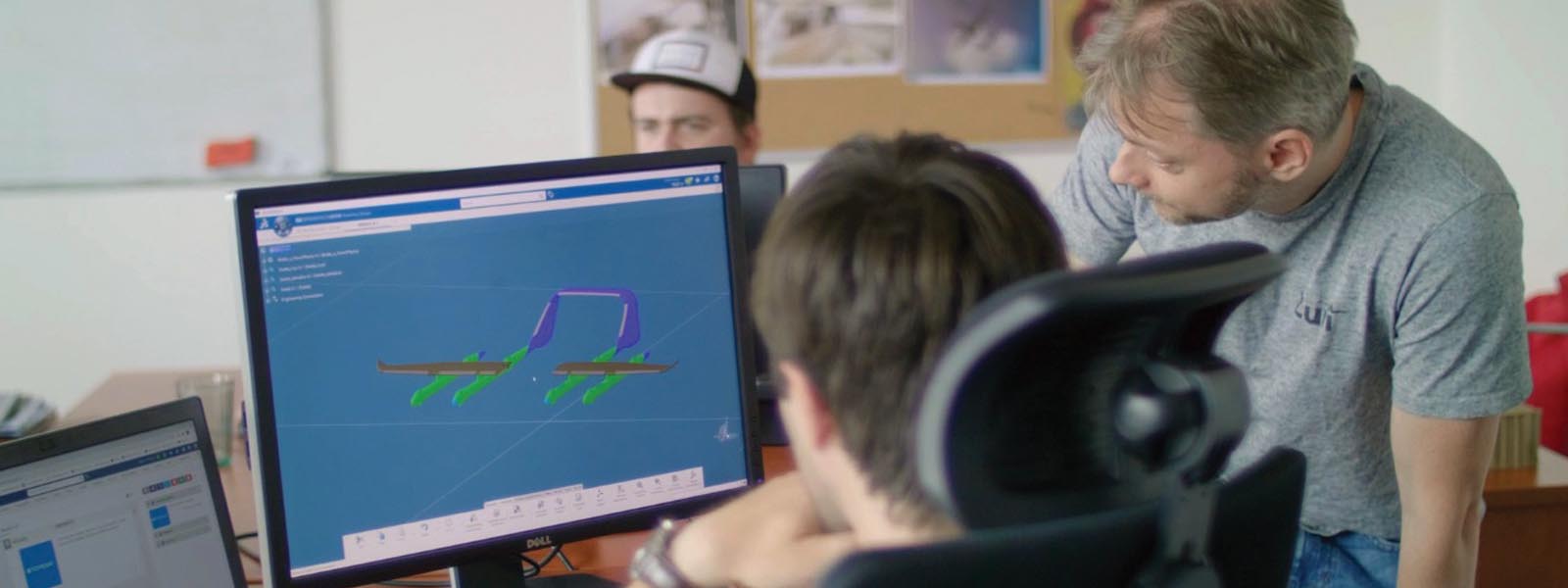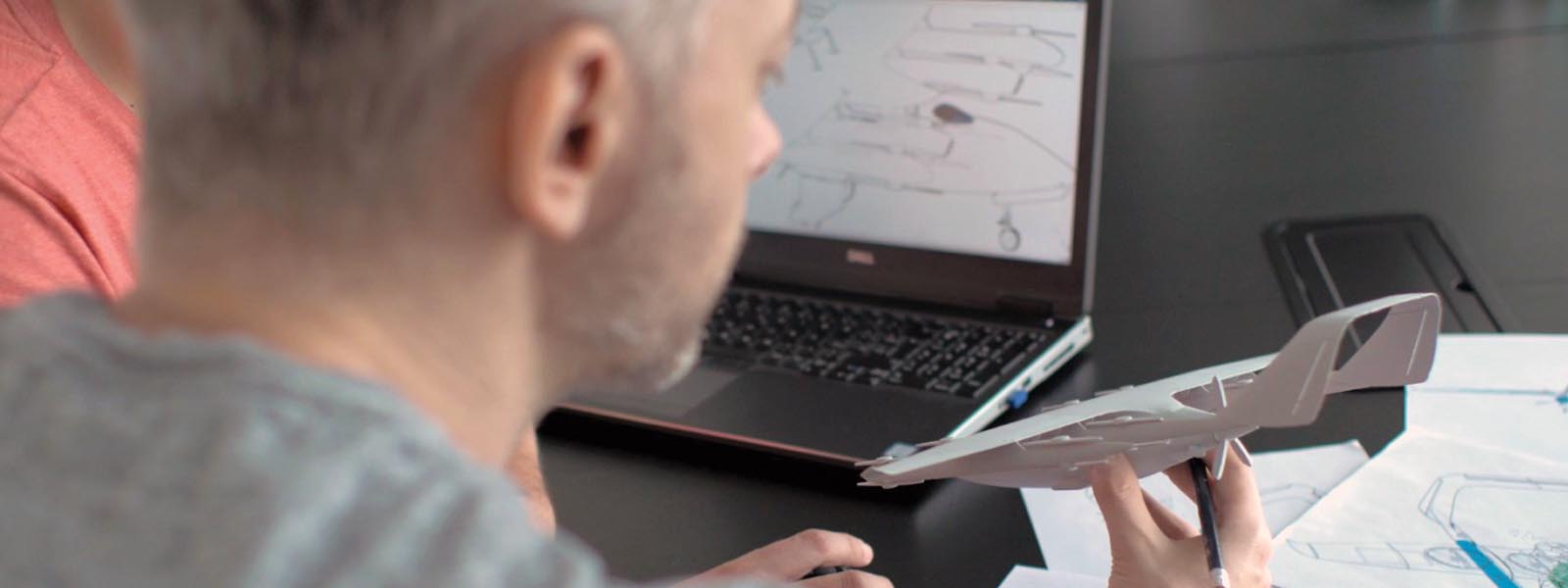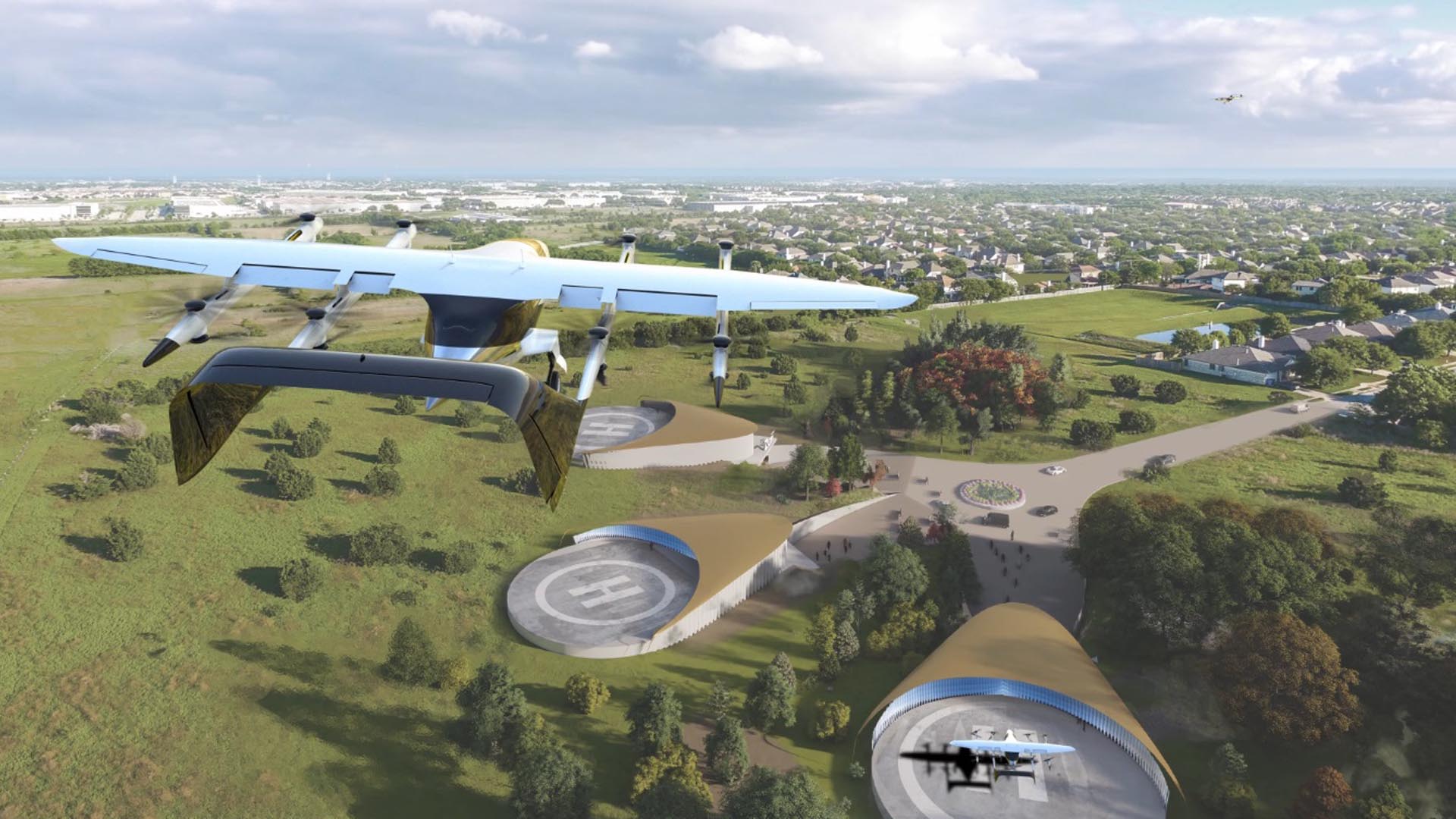Zuri
Czech-based startup Zuri plans to revolutionize the way people travel by making air transportation more accessible and efficient. The company adopted Dassault Systèmes’ 3DEXPERIENCE platform on the cloud with the Reinvent the Sky industry solution experience to design and produce its VTOL aircraft, create a virtual experience twin and connect all stakeholders.
Taking off at a moment's notice
Zuri is on a mission to transform the way that people travel. The Czech aerospace startup is in the process of developing a hybrid VTOL passenger aircraft, which is a cross between a conventional airplane and a multicopter – combining wings for fast horizontal flight with electric motors that allow for vertical take-off and landing. Instead of having to travel out to a regional airport to catch a flight, passengers will simply book a journey with Zuri and take off from a remote spot in their hometown’s periphery or a skyscraper’s roof – no long landing strips required – and head to their desired destination.
The man behind this vision is Czech entrepreneur Michal Illich, a frequent flier who has grown tired of getting stuck in traffic jams en route to airports. Instead of travelling hours to the nearest regional airport before checking in and processing prior to departure, Illich sees a future where travel is more accessible and instantaneous. Zuri’s personal aircraft is designed with exactly this in mind.
“Today, we spend far too much time before we even get in the airplane,” said Michal Illich, founder and CEO of Zuri. “When you have smaller airplanes and more available heliports, we can avoid long waiting and travel times. My aim is to develop a personal VTOL aircraft that can take you to wherever you want to go. It will all be much faster and more convenient with short travel time to the heliport and a fast checking-in process, helping to really improve the passenger experience and speed up the entire process.”
Zuri’s goal is to open up the opportunity for people to experience on-demand, door-to-door mid-range flights. So rather than driving hours in a car, it will be just as easy to get in a Zuri aircraft.
“We are a bit different from other VTOLs on the market,” Illich said. “Whereas multicopters are great at short distances and ideal for vertical take-off, they’re not efficient for cruise flights. For the horizontal part of the flight, we rely on wings, which are ideal for covering longer distances. This design makes Zuri more efficient compared to multicopters on the market and more suited to ranges between 200 and 700 km.”
Zuri’s hybrid power set up is another differentiating factor between its plane and other models on the market.
"We believe that battery technology isn’t quite ready for an electric VTOL aircraft yet so our solution is a hybrid plane,” Illich said. “We rely on electricity generated from the turbine as this is where we can gain the most efficiency. With a hybrid set up, NASA estimates airplanes can save 25% on fuel. Our sustainable model is the ideal middle step between traditional aerospace and the future, which will be fully electric.”
Creating a virtual twin is a natural thing for us to manage the aircraft’s lifecycle. We can start virtually, resolve any design issues, define the assembly process and then build it.
Scaling up with enterprise level IT
As it brings its VTOL hybrid plane to life, Zuri needed an industry-standard design and product development platform to replace the various design tools being used across the organization, connect its disciplines and scale with the business. The 3DEXPERIENCE® platform on the cloud was an ideal fit.
“We had already developed and modified our one-seater prototype using SOLIDWORKS and used some other CAD applications to create the smaller parts,” Illich said. “We needed more licenses and data migration between the tools was sometimes difficult, so we were looking for a single solution for everyone. Our engineers and CTO preferred CATIA and we liked the new design application within the 3DEXPERIENCE platform, so it made sense for our business as we grow.”
Zuri worked with Technodat, one of the largest Czech and Slovak Dassault Systèmes business partners, on the implementation. “They were really helpful from the beginning and answered all our queries,” Illich said. “They negotiated our startup conditions and got us the right tools to efficiently develop our aircraft while keeping IT costs under control.”
Zuri continues to explore the full potential of the 3DEXPERIENCE platform but is already using CATIA to handle the early stages of final product development for initial analysis, aerodynamics and measurements. “CATIA is the worldwide standard in aircraft design,” Illich said. “And the cloud version is ideal for a startup like us to benefit from the same solution that bigger players in our industry are used to working with. It allowed the team to start immediately, without the need to equip the company with an expensive IT infrastructure and to flexibly change the structure of the applications according to our changing needs. We like that everybody can securely work on the platform from any device connected to the internet, share data and have data versioning under control.”

Taking the business from concept to reality
Backed by the 3DEXPERIENCE platform, Zuri is in the best position to accelerate the product development lifecycle of its VTOL aircraft and gain significant advantage by being the first to market this concept.
“With our previous tools we got into a situation where it wasn’t possible to model the planes with the quality and precision we needed,” Illich said. “Now, we can achieve that and bring together the entire team on the platform to validate each prototype. This is really important as every individual provides input from their area of expertise. We also want them to think like future customers and share their personal thoughts from a user perspective to ensure we deliver the best possible experience.” ENOVIA on the 3DEXPERIENCE platform supports Zuri to define requirements, collaborate in real time and have full traceability from initial concept through certification and manufacturing.
ENOVIA also allows Zuri’s team to access and reuse common processes and parts to speed up time to market. “The unified 3DEXPERIENCE user environment allows us to collaborate efficiently not only within the internal team but also with part suppliers,” Illich said. “With the cloud, we can develop much faster and reduce the number of errors we make from incorrect versioning. We also like that configuration management and commenting functionality is interlinked with modules so we can measure the lifecycle of all the different components of our product.”
Zuri will also use the platform to navigate the complex process of testing and certifying its plane, using integrated safety processes and full traceability to comply with the multiple regulations governing the aerospace industry. Taking advantage of sensitivity analyses and what-if scenarios, it will be able to evaluate the reliability and robustness of its design while integrating cost and manufacturing models in the development process. This will give Zuri confidence to move forward from concept to final delivery stage, and guarantee reliable performance. “CATIA is known in the industry so the certification authorities are used to working with CATIA outputs,” Illich said. “We know that gaining certification will be a difficult process, but we now have the right technology in place to help us cover every basis.”
The cloud version is ideal for a startup like us to benefit from the same solution that bigger players in our industry are used to working with.
Virtual aircraft winning investor support
One of the key benefits offered by the 3DEXPERIENCE platform is the ability to develop a virtual experience twin in parallel with the development of the physical aircraft. This is useful in three ways: to test and verify a virtual prototype before committing to building a physical version of the aircraft; to manage and maintain the aircraft throughout its lifecycle; and to deliver an immersive virtual experience to investors, customers and prospects so they can easily explore the aircraft before it’s even built.
Working with its implementation partner Technodat on the virtual experience twin of its aircraft using the 3DEXPERIENCE platform, Zuri is able demonstrate its VTOL aircraft to investors and customers, complete with interior design mock-ups and a flight simulation.
“This allows us to present Zuri while we’re still in the design phase, before it physically exists,” Illich said. “We made a virtual twin of the one-seater prototype. This model is what we used for our presentation to investors. It’s basically the entire experience: the interior, switching between the cargo and seated version. We even simulated the aircraft taking off and flying away, so they can see the VTOL in action. It’s high-impact storytelling in action. With this interactive, realistic experience, combined with real-time development data, we can demonstrate to them that this is a winning concept they can trust and invest in.”
As Zuri ramps up its marketing activities to promote its business, the virtual experience will play a key role in how the company presents itself to the public and develops a fully commercially operable aircraft. “Creating a virtual twin is a natural thing for us to manage the aircraft’s lifecycle,” Illich said. “It’s crucial as we need it to define the work and development of the aircraft itself. We can start virtually, resolve any design issues, define the assembly process and then build it.”
Taking this approach, Zuri will be able to build a clear regulation and certification pipeline that covers all means of compliance, backed up with virtual models, methods, mathematical formulae and test results

Building towards a healthier future
When it launches its aircraft on the market – planned within the next five years – Zuri hopes it will not only address society’s need for more sustainable and environmentally friendly travel, but address people’s ongoing health concerns too.
“By the time our aircraft is on the market, we will hopefully have overcome COVID-19,” Illich said. “But for those people who may feel more comfortable travelling in smaller groups, this is something we can support with our aircraft, which will seat up to four people. And from an environmental point of view, high emissions are mostly driven by the overall weight of the aircraft. It’s worth considering that many planes today don’t travel at full capacity, so we are a great solution in that respect too. We’re smaller and far more efficient.”

Focus on Zuri
Zuri builds VTOL aircraft with the aim of changing the way people experience on-demand, door-to-door mid-range flights. It wants to enable people to travel on their own schedule and without airports, all secured by technology and design that doesn’t compromise on passengers’ safety and comfort.
For more information: zuri.com

Focus on Technodat
For more than 25 years, Technodat has been a preferred PLM (Product Lifecycle Management) and 3D solutions partner to customers of all sizes and in all industries, helping them develop and manufacture better products and innovative services faster. Technodat provides value-added business consulting services, PLM project implementation and integration, training and support to its 250 customers in the Czech Republic and Slovakia. Technodat is a leading integrator and distributor of 3D PLM solutions from Dassault Systèmes in the Czech Republic and Slovakia.
For more information: www.technodat.eu

